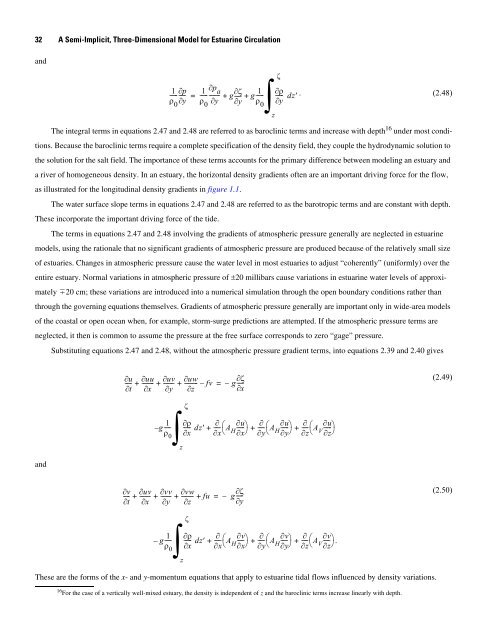A Semi-Implicit, Three-Dimensional Model for Estuarine ... - USGS
A Semi-Implicit, Three-Dimensional Model for Estuarine ... - USGS
A Semi-Implicit, Three-Dimensional Model for Estuarine ... - USGS
You also want an ePaper? Increase the reach of your titles
YUMPU automatically turns print PDFs into web optimized ePapers that Google loves.
32 A <strong>Semi</strong>-<strong>Implicit</strong>, <strong>Three</strong>-<strong>Dimensional</strong> <strong>Model</strong> <strong>for</strong> <strong>Estuarine</strong> Circulation<br />
and<br />
1<br />
----ρ<br />
0<br />
p ∂<br />
-----<br />
∂y<br />
1<br />
----ρ<br />
0<br />
p ∂<br />
a<br />
-------- g<br />
∂y<br />
ζ ∂<br />
----- g<br />
∂y<br />
1<br />
=<br />
ζ<br />
∫∂ρ<br />
+ + ----- ----- dz′ .<br />
ρ<br />
0<br />
∂y<br />
z<br />
(2.48)<br />
The integral terms in equations 2.47 and 2.48 are referred to as baroclinic terms and increase with depth 16 under most condi-<br />
tions. Because the baroclinic terms require a complete specification of the density field, they couple the hydrodynamic solution to<br />
the solution <strong>for</strong> the salt field. The importance of these terms accounts <strong>for</strong> the primary difference between modeling an estuary and<br />
a river of homogeneous density. In an estuary, the horizontal density gradients often are an important driving <strong>for</strong>ce <strong>for</strong> the flow,<br />
as illustrated <strong>for</strong> the longitudinal density gradients in figure 1.1.<br />
The water surface slope terms in equations 2.47 and 2.48 are referred to as the barotropic terms and are constant with depth.<br />
These incorporate the important driving <strong>for</strong>ce of the tide.<br />
The terms in equations 2.47 and 2.48 involving the gradients of atmospheric pressure generally are neglected in estuarine<br />
models, using the rationale that no significant gradients of atmospheric pressure are produced because of the relatively small size<br />
of estuaries. Changes in atmospheric pressure cause the water level in most estuaries to adjust “coherently” (uni<strong>for</strong>mly) over the<br />
entire estuary. Normal variations in atmospheric pressure of ±20 millibars cause variations in estuarine water levels of approxi-<br />
mately �20 cm; these variations are introduced into a numerical simulation through the open boundary conditions rather than<br />
through the governing equations themselves. Gradients of atmospheric pressure generally are important only in wide-area models<br />
of the coastal or open ocean when, <strong>for</strong> example, storm-surge predictions are attempted. If the atmospheric pressure terms are<br />
neglected, it then is common to assume the pressure at the free surface corresponds to zero “gage” pressure.<br />
and<br />
Substituting equations 2.47 and 2.48, without the atmospheric pressure gradient terms, into equations 2.39 and 2.40 gives<br />
∂u<br />
∂uu<br />
∂uv<br />
∂uw<br />
----- + -------- + -------- + --------- – fv g<br />
∂t<br />
∂x<br />
∂y<br />
∂z<br />
ζ ∂<br />
= – -----<br />
∂x<br />
g 1<br />
ζ<br />
∫∂ρ<br />
∂<br />
----- ----- dz′ ----- ⎛ ∂u<br />
A ----- ⎞ ∂<br />
----- ⎛ ∂u<br />
ρ0 ∂x<br />
∂x⎝<br />
H A ----- ⎞ ∂ ∂u<br />
–<br />
+ + ----<br />
∂x⎠<br />
∂y⎝<br />
H + ⎛A----- ⎞<br />
∂y⎠<br />
∂z⎝<br />
V ∂z⎠<br />
z<br />
∂v<br />
∂uv<br />
∂vv<br />
∂vw<br />
---- + -------- + ------- + --------- + fu g<br />
∂t<br />
∂x<br />
∂y<br />
∂z<br />
ζ ∂<br />
= – -----<br />
∂y<br />
g 1<br />
ζ<br />
∫∂ρ<br />
∂<br />
----- ----- dz′ ----- ⎛ ∂v<br />
A -----⎞<br />
∂<br />
----- ⎛ ∂v<br />
ρ0 ∂x<br />
∂x⎝<br />
H A -----⎞<br />
∂ ∂v<br />
–<br />
+ + ----<br />
∂x⎠<br />
∂y⎝<br />
H + ⎛A----- ⎞<br />
∂y⎠<br />
∂z⎝<br />
V .<br />
∂z⎠<br />
z<br />
These are the <strong>for</strong>ms of the x- and y-momentum equations that apply to estuarine tidal flows influenced by density variations.<br />
16 For the case of a vertically well-mixed estuary, the density is independent of z and the baroclinic terms increase linearly with depth.<br />
(2.49)<br />
(2.50)

















